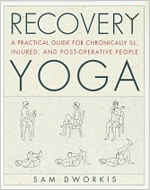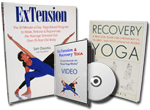
Recovery Yoga is a guide for those with chronic illness, injuries, or age-related lessening of mobility. This is a graduated program that can be practiced successfully by people who are unable to exercise normally, and for who are bedridden, confined to a chair, or limited in their mobility for any reason.
With this program, people with limited mobility can use yoga to take charge of their own health and restore a sense of control over their lives. When appropriately practiced, Recovery Yoga can promote feelings of well-being and to whatever extent is possible, to accelerate healing.
Under normal circumstances, you don't feel your body. It's just there operating in the background providing you with the vehicle that takes you about your daily business.
However when you are chronically ill or injured, your body no longer feels as if it is in the background. It is ever present reminding you that your former comfort and freedom of movement is compromised or no longer exists. This program is designed not only to give your body a jump-start toward wellness, but to take your mind off the discomfort of your body, quiet your mind and offer you some relief.
Recovery Yoga is a guide for anyone who feels their body is failing them, be it from chronic illness, injury, surgery, or from just growing older. This book will assist you in taking responsibility for your own health maintenance, and will give you practical tools to use for feeling better about yourself, both physically and emotionally.
A Personal Message from Sam Dworkis:
Below are two lengthy excerpts from Recovery Yoga which I hope will give you a feeling for the importance of this program.
Before I became ill, I used to tell people who came to me for "remedial yoga," that there was no "magic bullet" to yoga. I said that for it to be effective, a person needs to do at least some of all its various modes (such as breathing exercises, forward bends, back bends, twists, standing poses, inversions, etc.).
But in recent years, my thinking has changed considerably. As I continue to study the nature and characteristics of fascia; I am starting to understand how illness and injury significantly contracts it, and how yoga can play a significant role in mitigating the pain and tightness that contracted fascia creates.
I had studied the characteristics of fascia years before I became ill; but it was what I learned from my own illness, which was codified by teaching others, that lead me to recognize that yoga indeed has a "magic bullet" The magic bullet of yoga comes from appropriate and simple fascia stretching. In this website, throughout the Mechanics of Yoga pages, I discuss the nature of fascia and its role in human physical dysfunction. I feel the more you understand fascia's mechanisms the more you will appreciate the concepts and principles of Recovery Yoga.
The first excerpt below is fundamentally important because it introduces the process by which to control your breathing and how to integrate your controlled breathing with the movement of your body.
The second excerpt discusses some of the actual movements of "the magic bullet," that serve to release hypertonic fascia; and thereby, to offer substantial relief of chronic body pain.
I encourage you to explore these pages and invite you to email me directly should you have any comments or questions that can help me to clarify this work.
Recovery Yoga Excerpts
Chapter 3
Physical therapists are fond of saying: “If you don't use it, you lose it!” But when you are chronically ill or injured or are recovering from surgery, traditional or standard exercise becomes nearly, if not totally, impossible. It's easy to become discouraged. Even if you are able to exercise, are you sure that those exercises are appropriate for your condition? ...
For more Recovery Yoga excerpts, Click Here.
Recovery Yoga Reviews
Ann Garrison Roswell, NM
When I retired, I decided at age 60 to try a little yoga. Even when I was young I was not flexible, so I am forever amazed at how much more flexible and balanced I now am. Over the past five years, my progress has been slow but steady. I am even more delighted about how much better I feel when I do yoga!
Yoga is really for everyone, not just younger, more flexible people. Every week I get to see what yoga can do for older people, including myself, and people with a variety of health problems. ...Read More





 Return to Top
Return to Top